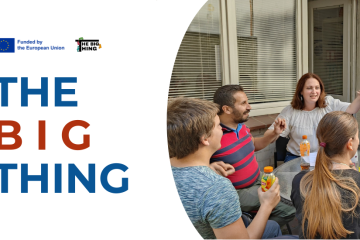This year, in collaboration with Loryhan asbl from Belgium, Nyílj meg! from Hungary, NGO Sakura from Romania, and Art House from Armenia, we launched the “Inclusion for All” project. The initiative aims to address disengagement and social exclusion while empowering young people with fewer opportunities to actively participate in their communities and become agents of change, particularly in the areas of sustainability and environmental protection.
The project primarily focuses on youth workers who support young people with disabilities or from disadvantaged backgrounds. Together, we aim to exchange experiences, share best practices, and explore strategies to make youth projects and activities fully inclusive and accessible.

Our first activity took place from 4 to 11 November, bringing together partners and youth workers from four European countries. During this week, we visited Bucharest and the Ilfov County in Romania, drawing inspiration from local organisations and educational institutions that are implementing inclusive programmes centred on ecological awareness.
During our visit, we had the privilege of experiencing the inspiring work at the Technological High School “Pamfil Șeicaru” in Ciorogârla, Ilfov County. This school, accompanying its formative offer with numerous Erasmus+ projects, has become a hub for initiatives on inclusion, democracy, and green awareness. These projects include youth exchanges across Europe on themes such as professional development, gender equality, democratic participation, and environmental awareness.

Collaborating with the school are nine European Solidarity Corps (ESC) volunteers and the staff of NGO Sakura. Together with the students, they run impactful development and awareness-raising activities. One example is the “Inclusion 1” project, where students, accompanied by ESC volunteers, dived into and exchanged insights into their countries’ histories, folklore, and religions.
The day concluded with a shared activities organised to show our similarities and a traditional Romanian dance, fostering connection and cultural exchange.

The following day, we visited the Technological High School “Cezar Nicolau” in Brănești, a bright example educational opportunities, inclusion and intercultural exchange. for its 950+ students. As an accredited Erasmus+ school, it offers mobility exchange programmes across Europe and hosts up to 60 participants annually for ecology-focused workshops. Partnering with NGO Sakura, the school collaborates with European Solidarity Corps (ESC) volunteers to engage students aged 16-18 in educational activities.
In the afternoon, we also had the opportunity to explore “PLANETISE”, a trivia game developed by NGO Sakura in a previous strategic partnership to make eco-awareness engaging and fun.

Tiago, an ESC volunteer collaborating with the school, shared insights into his role and introduced us to an activity he designed for students: we went on the school grounds looking for natural elements – leaves, branches, flowers – with which each team made an aesthetic arrangement. Collaborating directly with him offered a valuable perspective on his work promoting inclusion and accessibility in environmental education.
He also shared a bit of his motivation and experience so far: “I came from an archipelago, the Azores, with a rich ecosystem, to explain the students about ecology and my experience in the islands, and to show them that, in the world we live in, we may have different mentalities but we can help each other for a better world, if we work together. […] The students are creative, I always try to use their ideas, so they learn from me and I learn from them – […] the best way to work with them is to connect theory with practice. For example, after I teach them about ecosystems, I have planned an activity to construct a small ecosystem with them. I want to see with their own eyes what we are doing to the planet”.
Another interesting highlight of the trip was the visit to the Văcărești Natural Park, a formerly abandoned concrete dam that over the decades developed a rich ecosystem. Local NGOs united in an initiative to protect the area from being sold for construction, and won their battle when the park was declared a protected area in 2014. Walking inside the park gave us a feel of the vastity of the area and of its biodiversity.

A special mention goes to the National Museum of Natural History “Grigore Antipa,” which is committed to making its collection accessible to all through a continuously evolving strategy shaped by feedback from visitors with disabilities. During our visit, one of our visually impaired participants contributed to this initiative by collaborating with the museum guide to assess the accessibility of the embossed renderings of the collection.
Our study visit provided valuable opportunities to reflect on the examples observed and lessons learned during our week in Bucharest, while also exchanging experiences and best practices from our own contexts. These reflections are crucial, as the outcomes from this visit, combined with the results of the upcoming training activity in March and our contributions, will form a set of guidelines aimed at helping youth workers make youth work more inclusive and accessible for all.
A special thanks to NGO Sakura for hosting us, we are looking forward to this project’s next activity in Belgium!


